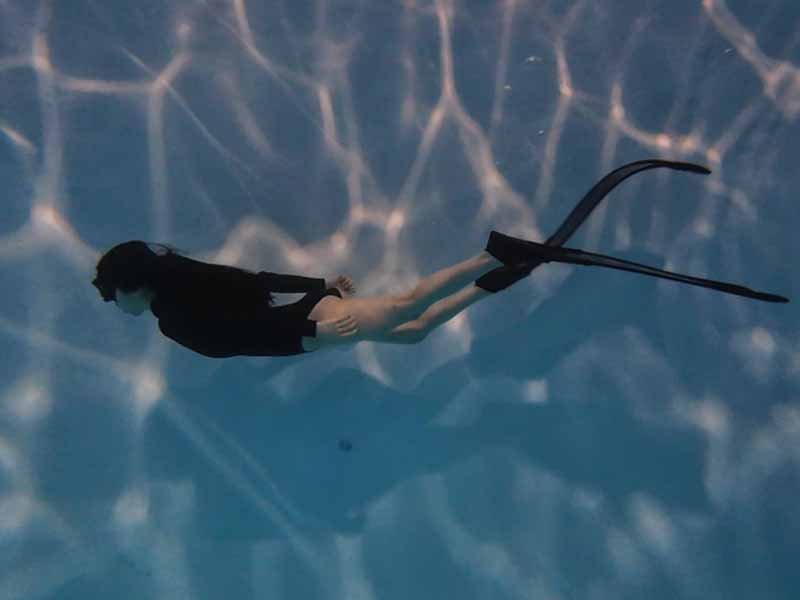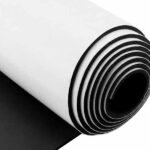Swimwear has come a long way from traditional fabrics like nylon and polyester. Today, neoprene swimsuits are making waves in both sports and fashion circles. Loved by surfers, divers, and even casual beachgoers, neoprene suits offer a unique blend of insulation, buoyancy, and style that regular swimsuits can’t match. Whether you’re a professional athlete or someone who just loves spending time by the water, understanding neoprene can help you choose the perfect gear for performance and comfort.
A neoprene swimsuit is made from synthetic rubber (neoprene), designed to provide insulation, buoyancy, and flexibility in water. Unlike regular swimsuits made of nylon or spandex, neoprene retains warmth, resists water absorption, and adds a layer of protection for sports like surfing, diving, and triathlons. It is also popular in fashion swimwear for its body-shaping effect and durability.
Imagine this: you’re gearing up for an early morning surf session. The water’s chilly, the waves are unpredictable, and you need gear that performs. A regular nylon swimsuit won’t cut it—you’d be shivering within minutes. But a neoprene swimsuit keeps your body warm, helps you float more easily, and even gives you a sleek, sculpted look. That’s why athletes and designers alike are embracing neoprene—it’s not just swimwear, it’s performance wear with attitude.
What Is a Neoprene Swimsuit and How Is It Different from Regular Swimwear?
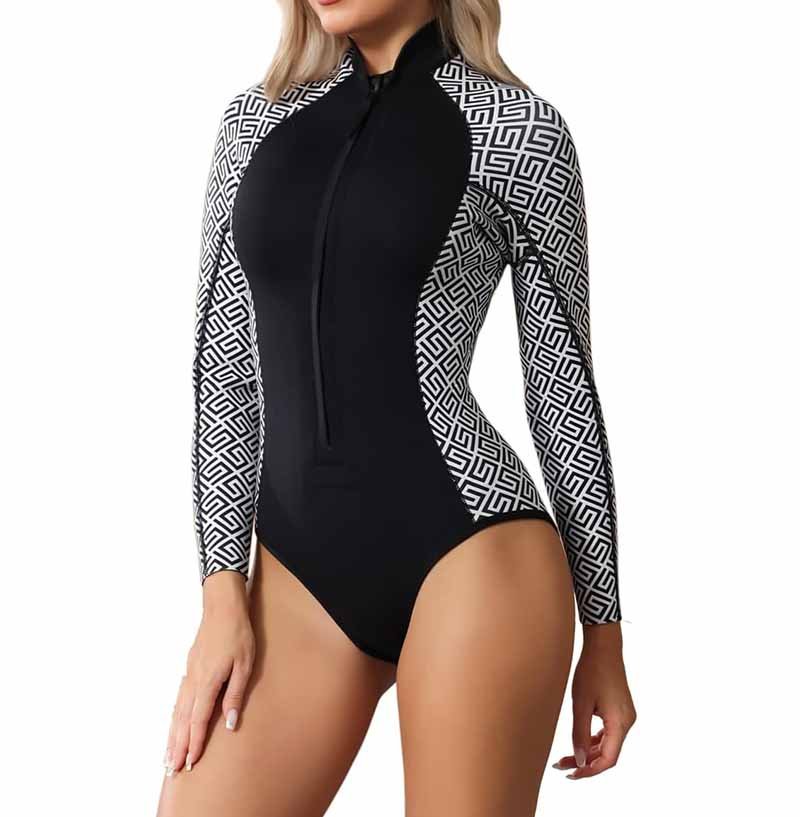
A neoprene swimsuit is made from synthetic rubber instead of nylon or polyester. It provides insulation, buoyancy, and protection in water sports. Unlike regular swimwear, neoprene retains body heat, resists water absorption, and adds durability, making it suitable for surfing, diving, and triathlons, while standard swimsuits are better for casual swimming and sunbathing.
Defining Neoprene Swimwear vs. Regular Fabrics
When buyers or consumers compare neoprene swimsuits to traditional swimwear, the first thing they notice is the difference in material composition. Traditional swimsuits are usually made of nylon, polyester, or spandex (lycra)—lightweight fabrics that dry quickly, breathe well, and stretch to provide comfort during casual swimming.
By contrast, neoprene is a synthetic rubber foam invented in the 1930s. It was originally designed for industrial use but quickly found its way into diving suits, wetsuits, and water sports gear due to its exceptional thermal insulation. This is why a neoprene swimsuit feels thicker, warmer, and more protective than a regular swimsuit.
1. Material & Structure Differences
Regular Swimwear Fabrics:
- Nylon & polyester are woven textiles.
- Spandex provides elasticity but offers no insulation.
- They absorb small amounts of water and dry fast in the sun.
Neoprene Foam:
- Closed-cell structure filled with tiny nitrogen bubbles.
- Provides buoyancy and insulation.
- Minimizes water absorption, keeping the suit warmer.
This structural difference explains why neoprene is associated with performance sports while nylon-based suits dominate casual leisurewear.
2. Performance in Water
- Regular Swimwear: Light, breathable, comfortable for sunbathing or recreational swimming. However, it offers no thermal protection, leaving swimmers exposed to cold water.
- Neoprene Swimsuits: Offer thermal insulation—trapping a thin layer of water between the body and the suit, which then warms up from body heat. This makes them suitable for cold or long-duration water activities such as surfing, snorkeling, or open-water swimming.
3. Aesthetic and Body-Shaping Qualities
One lesser-known benefit of neoprene is its sculpting effect. Because it’s thicker and less elastic than nylon, it shapes the body more like a compression garment. Many fashion swimwear designers now use thin neoprene (1–2mm) to create trendy, structured swimsuits that enhance body lines and maintain shape better than spandex-only suits.
4. Comparative Overview
| Feature | Neoprene Swimsuit | Regular Swimwear (Nylon/Spandex) |
|---|---|---|
| Material | Synthetic rubber (closed-cell foam) | Nylon, polyester, spandex blend |
| Thermal Insulation | High – retains warmth in water | None – body loses heat quickly |
| Buoyancy | Adds flotation support | Neutral buoyancy |
| Flexibility | Moderate – stretches less than spandex | High – excellent stretch and movement |
| Water Absorption | Very low | Low to moderate |
| Use Case | Sports, surfing, diving, triathlons | Casual swimming, sunbathing, fashion |
| Body Shaping | Strong sculpting, firm fit | Flexible, less structural |
Which Types of Neoprene Swimsuits Are Available?
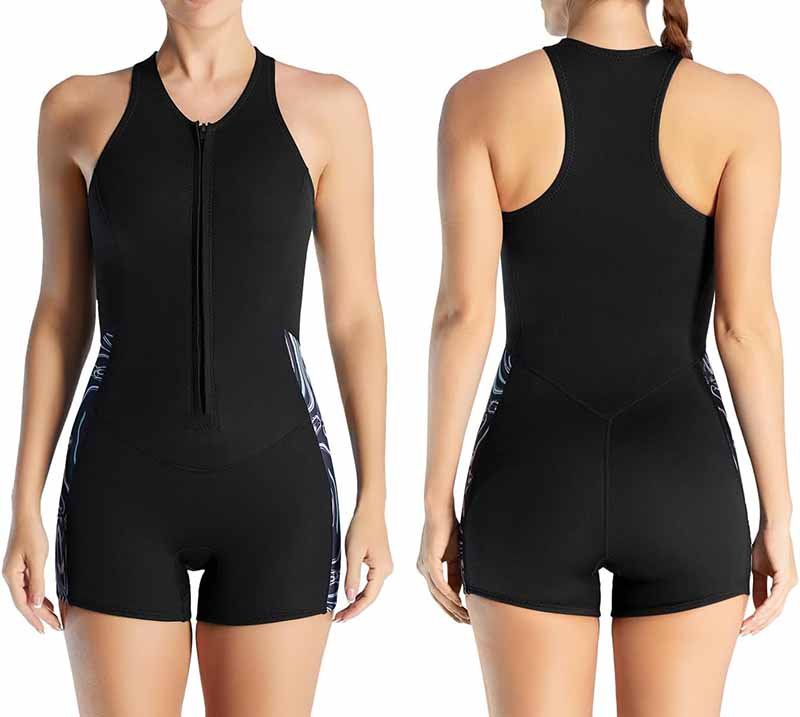
Neoprene swimsuits come in multiple styles: one-piece and two-piece suits for fashion or casual swimming, wetsuits and spring suits for surfing and diving, and varying thicknesses (1mm, 2mm, 3mm) to balance flexibility and insulation. Thin neoprene is used in trendy swimwear, while thicker suits are designed for water sports and colder environments.
Categories of Neoprene Swimwear
Not all neoprene swimsuits are the same. Depending on the design, thickness, and intended use, the variety of neoprene swimwear can meet very different customer demands—from sport athletes to fashion-conscious beachgoers.
1. One-Piece vs. Two-Piece Neoprene Swimsuits
- One-Piece: Offers more coverage and support. Popular among surfers, divers, and women seeking body shaping. The structured neoprene helps maintain silhouette and prevents sagging compared to nylon suits.
- Two-Piece: Provides flexibility and freedom of movement. Often chosen by younger swimmers and casual users who want both function and fashion. Designers use neoprene panels to create bold color-blocked bikinis that hold shape in water.
2. Wetsuits and Spring Suits
- Full Wetsuits: Typically 2–5mm neoprene, covering arms and legs. Designed for surfing, scuba diving, triathlons, and cold-water swimming. These focus on insulation and body protection.
- Spring Suits (Shorties): Feature short sleeves and legs, usually 1–3mm thick. Popular in warmer waters, offering a balance between mobility and warmth. Great for surfing in mild climates or snorkeling in tropical seas.
3. Fashion Neoprene Swimsuits
Fashion designers use thin neoprene (1–2mm) to create structured, sculpted swimsuits. These are less about thermal performance and more about aesthetic appeal:
- Maintain shape when wet.
- Offer a “body sculpting” effect like shapewear.
- Allow bold colors, laser-cut patterns, and unique designs not possible with nylon or spandex.
4. Thickness Levels and Performance
The thickness of neoprene determines both comfort and function:
| Thickness | Common Use Case | Performance Traits |
|---|---|---|
| 1mm | Fashion swimwear, warm-water recreation | Light insulation, high flexibility |
| 2mm | Spring suits, light surfing, snorkeling | Moderate warmth, good movement balance |
| 3mm | Wetsuits for surfing/diving in cooler waters | Strong insulation, reduced flexibility |
| 5mm+ | Scuba diving, triathlons in cold waters | High insulation, lower mobility |
5. Specialty Styles
- Triathlon Swimsuits: Ultra-light neoprene designed to enhance buoyancy while reducing drag.
- Surf Suits: Reinforced seams and panels for durability against saltwater and friction.
- Hybrid Swimsuits: Combine neoprene with other fabrics like spandex for enhanced comfort and design flexibility.
How Do Neoprene Swimsuits Work in Water Sports and Swimming?
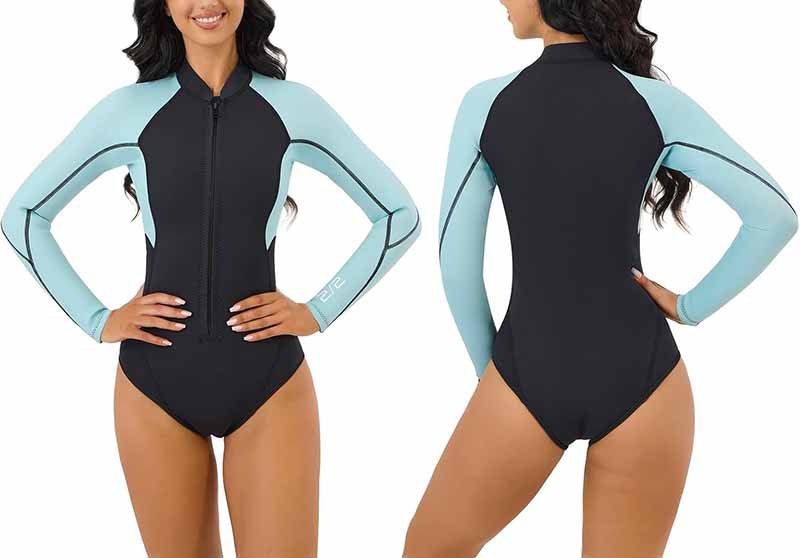
Neoprene swimsuits work by trapping a thin layer of water between the body and the suit, which warms up from body heat to provide insulation. The closed-cell foam also adds buoyancy and protection, making neoprene ideal for surfing, diving, triathlons, and open-water swimming. Regular swimsuits cannot provide the same thermal insulation, flotation, or durability in demanding sports environments.
The Science and Applications of Neoprene Swimwear
The popularity of neoprene swimsuits in water sports comes from their unique physical properties. Unlike nylon or polyester, neoprene is not just a fabric—it’s a synthetic rubber with closed-cell foam filled with tiny nitrogen bubbles. This special structure explains why neoprene provides insulation, buoyancy, and impact protection, making it essential for athletes and adventure swimmers.
1. Insulation and Warmth
- Neoprene doesn’t keep water out completely. Instead, it traps a thin layer of water between the body and the suit.
- This layer quickly warms up from body heat and forms a protective barrier against cold water.
- For example, a 3mm neoprene suit can extend comfortable swimming time in 15–20°C water compared to a nylon swimsuit where body heat would be lost within minutes.
2. Buoyancy Support
- The gas-filled foam cells inside neoprene make it naturally buoyant.
- For beginners learning to swim or triathletes needing energy efficiency, this buoyancy helps reduce fatigue and improve body position in the water.
- This is one reason triathlon wetsuits are often made of thin, hydrodynamic neoprene panels.
3. Protection Against External Elements
- Neoprene provides a buffer against abrasions, stings, and UV rays. Surfers appreciate this when lying on boards, while divers value protection against corals and marine life.
- Its resistance to saltwater and chemicals makes it longer-lasting in ocean environments compared to regular swimwear.
4. Applications Across Water Sports
- Surfing: Neoprene spring suits and wetsuits keep surfers warm, flexible, and protected from board friction.
- Diving: Scuba divers use thicker neoprene (3–5mm) for extended cold-water dives.
- Triathlons: Athletes rely on thin neoprene suits for buoyancy and streamlined movement.
- Recreational Swimming: Casual swimmers use lightweight neoprene swimsuits for comfort in slightly cooler pools or oceans.
5. Performance vs. Casual Use
While neoprene swimsuits are superior for performance sports, they may feel stiffer and warmer in casual pool use. This is why they are not a universal replacement for traditional swimwear. Instead, neoprene fills the niche where thermal comfort and performance are critical.
Performance Comparison: Neoprene vs. Regular Swimwear in Water
| Feature | Neoprene Swimsuit | Regular Nylon/Polyester Swimwear |
|---|---|---|
| Insulation | Traps warm water, maintains body heat | No insulation, rapid heat loss |
| Buoyancy | Increases flotation, reduces fatigue | Neutral, no added buoyancy |
| Durability in Sports | High resistance to salt, abrasion, UV | Weaker against chlorine/salt exposure |
| Protection | Shields from stings, scratches, UV | Minimal protection |
| Best Use Case | Surfing, diving, triathlons, open water | Casual pool or beach swimming |
Is a Neoprene Swimsuit Comfortable to Wear?
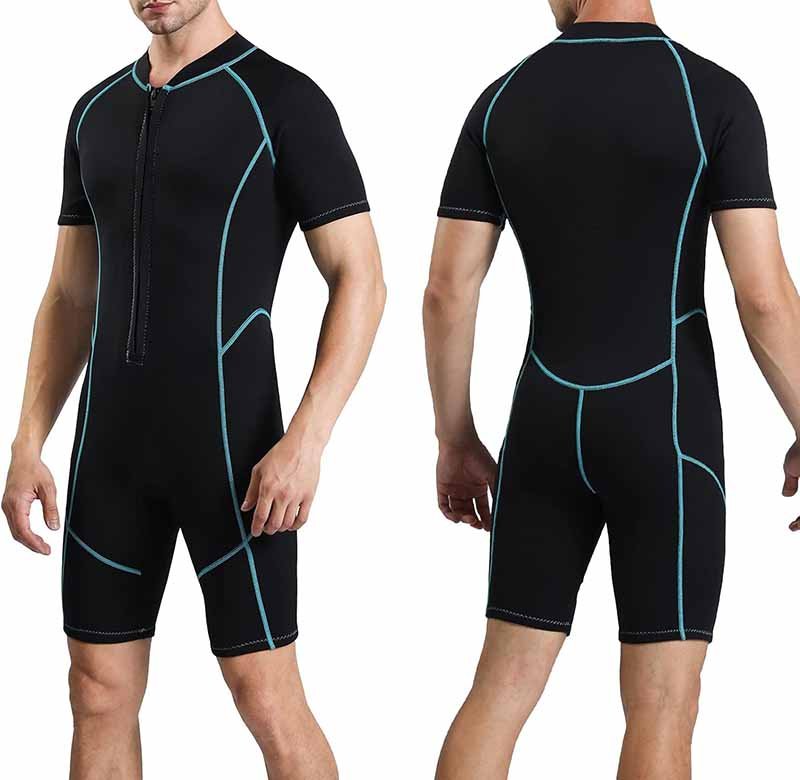
A neoprene swimsuit is generally comfortable, offering body support, buoyancy, and warmth, but it is thicker and less breathable than nylon swimwear. While it fits snugly and sculpts the body, it can feel warmer on hot days and may cause mild skin irritation if worn for long hours without proper sizing or lining. Comfort depends on thickness, fit, and intended use.
Comfort, Flexibility & Ergonomics
When customers consider neoprene swimsuits, comfort is one of the first concerns. Unlike thin nylon or polyester suits, neoprene has a firmer, thicker structure. This brings both advantages in support and warmth and challenges in breathability and flexibility.
1. Fit and Support
- Neoprene swimsuits are designed to fit tightly, almost like a second skin.
- This snug fit helps reduce drag in the water, improves buoyancy, and provides a sculpted silhouette many customers find flattering.
- Compared to spandex-based swimsuits, neoprene offers more body shaping and stability, similar to light compression wear.
2. Flexibility and Mobility
- Neoprene has natural elasticity but less than lycra or spandex.
- Thin neoprene (1–2mm) provides good freedom of movement for casual swimming or fashion suits.
- Thicker neoprene (3–5mm), as used in wetsuits, may feel restrictive, especially around shoulders and arms during long swims.
- To solve this, manufacturers often design multi-panel suits with flexible neoprene blends around high-movement areas.
3. Heat and Breathability
- Neoprene insulates, which is excellent in cool or open water environments, but can feel overly warm in hot climates.
- Regular swimwear fabrics like nylon or polyester breathe better, making them more comfortable for pool lounging or tropical beaches.
- Many modern neoprene swimsuits use mesh linings or thinner panels to balance warmth and breathability.
4. Skin Contact and Irritation
- Some users report chafing or rashes when wearing neoprene for extended periods, especially if the suit is too tight or poorly stitched.
- High-quality neoprene swimsuits often have smooth linings (nylon jersey or lycra) to reduce friction.
- Proper sizing is critical: a neoprene suit should feel snug but not painfully tight.
5. Perceived Comfort in Different Use Cases
- Recreational Swimmers: Enjoy the support and shaping effect but may find neoprene warmer in sunny conditions.
- Athletes (surfers, divers, triathletes): Value insulation and snug fit over breathability. Comfort here is linked to performance.
- Fashion Buyers: Choose thin neoprene swimsuits for their structured look and body-sculpting benefits.
Comfort Comparison: Neoprene vs. Nylon Swimwear
| Factor | Neoprene Swimsuit | Regular Nylon/Spandex Swimwear |
|---|---|---|
| Fit | Snug, sculpted, body shaping | Flexible, looser, stretch-focused |
| Flexibility | Moderate (thickness-dependent) | Very high, stretches in all angles |
| Warmth | High – retains body heat | Low – no insulation |
| Breathability | Low – can feel warm in hot weather | High – comfortable in tropical areas |
| Skin Comfort | May chafe without lining or wrong fit | Soft, breathable, minimal irritation |
Are Neoprene Swimsuits Durable and Easy to Maintain?
Yes, neoprene swimsuits are durable, resisting saltwater, UV, and abrasions, but their lifespan is usually 3–5 years with regular use. They are easy to maintain—simply rinse with fresh water, air dry in shade, and avoid machine washing or heat exposure. With proper care, neoprene retains elasticity and performance much longer than standard swimwear fabrics.
Durability and maintenance are critical factors for both consumers and buyers. A neoprene swimsuit costs more than a nylon one, so customers want reassurance that it will last long enough to justify the investment.
1. Average Lifespan of Neoprene Swimsuits
- Heavy Use (athletes, surfers, divers): Around 2–3 years before elasticity weakens.
- Casual Use (occasional swimming or fashion wear): 4–5 years or longer.
- Compared to nylon swimwear, which often loses shape after 1–2 seasons, neoprene clearly lasts longer.
2. Resistance to Environmental Stress
- Saltwater & Chlorine: Neoprene resists salt and mild chlorine exposure, making it better for ocean use. However, frequent chlorinated pool use can dry out neoprene faster.
- UV Rays: Extended sun exposure can degrade neoprene over time, causing brittleness or fading.
- Abrasion: More resistant than nylon or spandex to scratches, sand friction, and contact with surfboards.
3. Common Weak Points
- Seams and Zippers: Poorly constructed seams may peel or split if not reinforced.
- Elasticity Loss: Neoprene eventually stiffens with age, reducing flexibility.
- Lining Damage: If nylon or lycra lining is thin, it may pill or fray earlier than the neoprene core.
4. Maintenance Tips for Longevity
- Rinse After Use: Always rinse in fresh, cool water after ocean or pool use to remove salt, sand, and chlorine.
- Dry Properly: Air dry in shade. Direct sunlight or heat (like dryers or radiators) damages neoprene cells.
- Storage: Hang on wide hangers to avoid creases, or store flat. Avoid folding for long periods.
- Cleaning: Use mild wetsuit shampoo occasionally. Never bleach or machine wash.
5. Comparison With Regular Swimwear Maintenance
- Neoprene requires slightly more care than nylon swimsuits, but the payoff is greater durability and performance longevity.
- Traditional swimsuits may survive machine washing but stretch out or fade quickly, while neoprene retains shape better if cared for correctly.
Durability & Maintenance Comparison Table
| Factor | Neoprene Swimsuit | Regular Nylon/Spandex Swimwear |
|---|---|---|
| Lifespan | 3–5 years (casual), 2–3 years (heavy use) | 1–2 seasons before losing elasticity |
| Saltwater Resistance | High – ideal for ocean use | Moderate – fibers weaken over time |
| Chlorine Resistance | Moderate – rinse immediately | High – but fades color quickly |
| UV Resistance | Moderate – avoid direct drying in sun | Low – prone to fading |
| Abrasion Resistance | Strong – resists sand/board friction | Weak – fabric pills or tears easily |
| Maintenance | Rinse, shade-dry, avoid heat | Simple wash, but short lifespan |
What Are the Pros and Cons of Choosing Neoprene Swimwear?
The main pros of neoprene swimwear are insulation, buoyancy, durability, and body shaping, making it ideal for water sports and cooler conditions. The cons include less breathability, heavier weight, slower drying time, and higher cost compared to nylon swimwear. Neoprene suits are performance-driven but may feel less comfortable for casual poolside use.
Like every material, neoprene comes with clear strengths and trade-offs. Understanding both sides helps buyers and consumers choose wisely.
1. Advantages of Neoprene Swimwear
- Thermal Insulation Neoprene’s closed-cell foam structure retains warmth, extending swimming time in cold or open water. Regular swimwear cannot provide this benefit.
- Buoyancy & Safety The nitrogen bubbles inside neoprene add flotation, helping swimmers maintain better body position and reducing fatigue. This is especially valuable for beginners and triathletes.
- Durability Resistant to saltwater, abrasion, and UV damage, neoprene swimwear lasts longer than nylon-based suits if properly maintained.
- Body Shaping Neoprene compresses and sculpts, giving swimmers a sleek silhouette. Fashion brands use this property to design structured bikinis and one-pieces that hold their shape better than spandex.
- Versatility Works across categories—from athletic wetsuits to high-fashion swimwear, appealing to different consumer groups.
2. Limitations of Neoprene Swimwear
- Breathability Neoprene is not breathable, which makes it feel warm in tropical climates or out of water.
- Flexibility Less elastic than spandex, so thicker suits may feel restrictive. Movement depends on thickness and panel design.
- Weight Neoprene swimsuits are heavier than nylon suits, especially when wet, though lighter than full scuba wetsuits.
- Drying Speed Neoprene takes longer to dry—hours compared to nylon’s quick-dry properties.
- Price Neoprene swimsuits usually cost more due to material and manufacturing complexity.
Pros vs. Cons Overview
| Aspect | Pros (Advantages) | Cons (Limitations) |
|---|---|---|
| Insulation | Retains body heat in cold water | Can feel too warm in hot climates |
| Buoyancy | Adds flotation, reduces fatigue | None (generally an advantage) |
| Durability | Resists salt, abrasion, UV | Loses elasticity after 2–5 years |
| Body Shaping | Sculpts and supports body lines | Fit may feel restrictive if sized poorly |
| Maintenance | Easy rinse and shade dry | Requires careful drying and storage |
| Drying Speed | — | Slower than nylon or spandex |
| Cost | Long lifespan justifies higher price | Higher upfront cost than regular swimwear |
How to Choose the Right Neoprene Swimsuit for Your Needs?
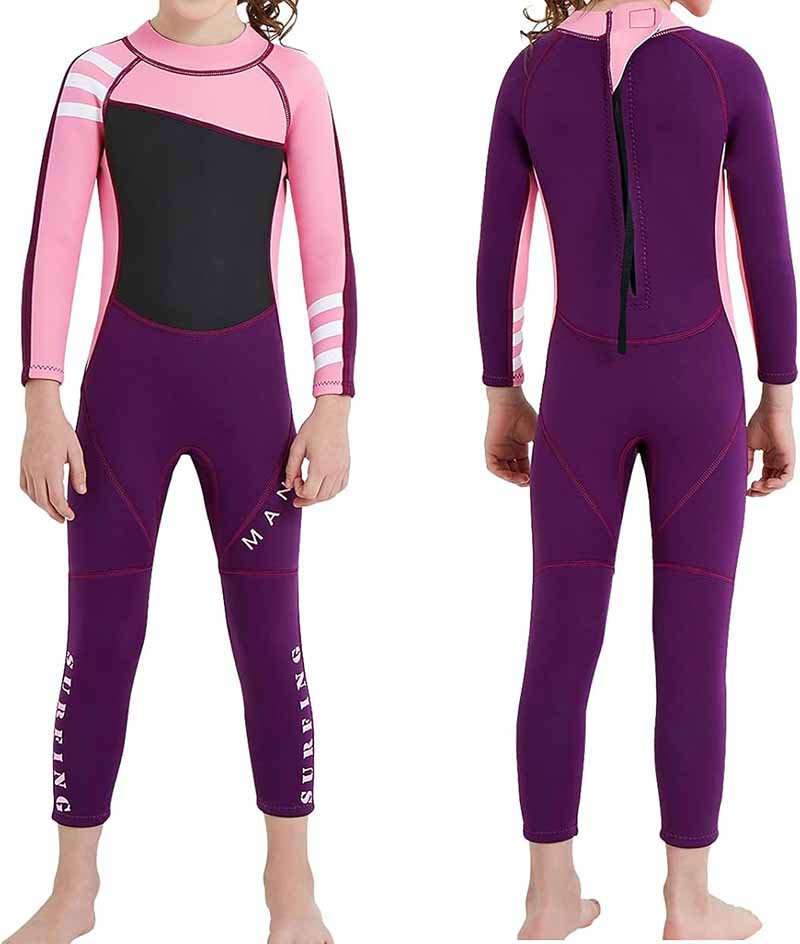
To choose the right neoprene swimsuit, consider thickness (1–2mm for warm water or fashion, 3–5mm for sports), fit (snug but not restrictive), style (one-piece, two-piece, wetsuit), and budget. Beginners should focus on comfort and flexibility, while professionals need performance-oriented designs with reinforced seams and advanced paneling.
Factors That Influence the Right Choice
Selecting a neoprene swimsuit is not one-size-fits-all. The right suit depends on who you are, where you swim, and what your goals are. Buyers should think in terms of thickness, fit, style, activity, and budget.
1. Thickness and Water Temperature
- 1mm–2mm: Perfect for fashion swimwear or warm-water activities. Lightweight, comfortable, and sculpting, but not highly insulating.
- 3mm: Great for surfing, snorkeling, or recreational diving in cooler waters (15–20°C).
- 5mm+: Designed for scuba divers and triathletes in colder environments. Offers superior insulation but less flexibility.
2. Fit and Comfort
- Should feel snug, like a second skin.
- If too loose, water flushes in and reduces insulation.
- If too tight, it restricts movement and causes discomfort.
- Look for designs with stretch panels around shoulders and arms for better mobility.
3. Style and Use Case
- One-Piece: Better for coverage, warmth, and sculpting.
- Two-Piece: Offers flexibility and trend appeal for casual users.
- Wetsuit/Spring Suit: Best for athletes or serious water sports.
4. Beginner vs. Professional Considerations
- Beginners: Should choose thinner neoprene (1–2mm), prioritizing comfort and affordability. Entry-level suits help ease into water sports.
- Professionals: Need advanced neoprene blends (super-stretch panels, reinforced seams, ergonomic shaping) for performance and durability.
5. Budget & Lifecycle Value
- Fashion Neoprene Swimwear: Typically costs more than nylon swimsuits but offers longer lifespan.
- Sport Neoprene Suits: Higher upfront cost but essential for safety and performance.
- Pro Tip for Buyers: Emphasize value in marketing—consumers will pay more if they understand the suit lasts 2–3× longer than a nylon suit.
Comparison Table: Choosing the Right Neoprene Swimsuit
| Factor | Beginner/Leisure User | Professional/Performance User |
|---|---|---|
| Thickness | 1–2mm for comfort and mobility | 3–5mm+ for insulation and performance |
| Fit | Flexible, not overly tight | Precision snug fit, ergonomic paneling |
| Style | Two-piece or light one-piece | Wetsuit or spring suit with reinforcements |
| Use Case | Beach, pool, casual snorkeling | Surfing, diving, triathlons |
| Budget Focus | Affordability, easy entry-level option | Higher investment, long-term durability |
Frequently Asked Questions (FAQ) About Neoprene Swimsuits
1. Do neoprene swimsuits stretch out over time?
Yes, neoprene can stretch slightly with frequent use, especially around high-movement areas like shoulders and waist. However, compared to nylon or spandex, neoprene holds its shape longer. To reduce stretching, always rinse after use, avoid hot water, and store flat or on wide hangers.
2. Are neoprene swimsuits waterproof?
No swimsuit is fully waterproof. Neoprene swimsuits are water-resistant, meaning they absorb far less water than nylon suits. They trap a thin layer of water that warms with body heat, providing insulation. This makes them excellent for surfing, diving, and triathlons but not a dry alternative to wetsuits or drysuits.
3. How should I wash and care for a neoprene swimsuit?
- Rinse in cool, fresh water after each use.
- Use mild wetsuit shampoo occasionally—avoid bleach or harsh detergents.
- Air dry in shade (never under direct sunlight or in a dryer).
- Store flat or on a wide hanger to prevent creases. Proper care extends lifespan from 2–3 years to 5 years or more for casual use.
4. Can I use a neoprene swimsuit in a pool with chlorine?
Yes, but chlorine can gradually degrade neoprene, causing stiffness or fading. Always rinse thoroughly after pool use. For frequent chlorine exposure, nylon or polyester swimsuits are more practical, while neoprene is best reserved for ocean and performance sports.
5. Is a neoprene swimsuit good for beginners?
Absolutely. Neoprene adds buoyancy and warmth, making beginners feel more confident in water. A thin 1–2mm neoprene swimsuit is ideal for entry-level swimmers or recreational snorkelers, as it balances comfort and flexibility without overwhelming stiffness.
6. Do neoprene swimsuits dry quickly?
Not as fast as nylon. Neoprene takes a few hours to dry completely because of its dense foam structure. To speed up drying, gently press out excess water, hang in a shaded, ventilated area, and avoid wringing or twisting the fabric.
7. Are neoprene swimsuits heavy to wear?
Neoprene is thicker than nylon, so it feels heavier, especially when wet. However, the buoyancy it provides in water offsets this feeling, making it easier to swim or float. A 2mm neoprene swimsuit is only slightly heavier than a nylon suit but much warmer and more protective.
8. How long does a neoprene swimsuit usually last?
With proper care, a neoprene swimsuit lasts 3–5 years under frequent use, and even longer (5–7 years) if worn occasionally. The most common signs of aging are reduced elasticity and seam wear. Investing in quality construction and reinforced stitching ensures a longer lifespan.
Conclusion
Choosing neoprene swimwear is about balancing performance, comfort, and style. Whether your audience is professional athletes, casual swimmers, or fashion buyers, neoprene offers unique strengths unmatched by regular swimwear.
At Szoneier, with 18+ years of neoprene expertise, we deliver:
- Custom designs with low MOQ starting at 50 pcs
- Rapid sampling (7–10 days) and short production lead times
- Free design service and logo customization
- Premium materials with OEKO-TEX® and REACH compliance
Contact Szoneier today to develop your own neoprene swimwear line and bring your vision to life.

